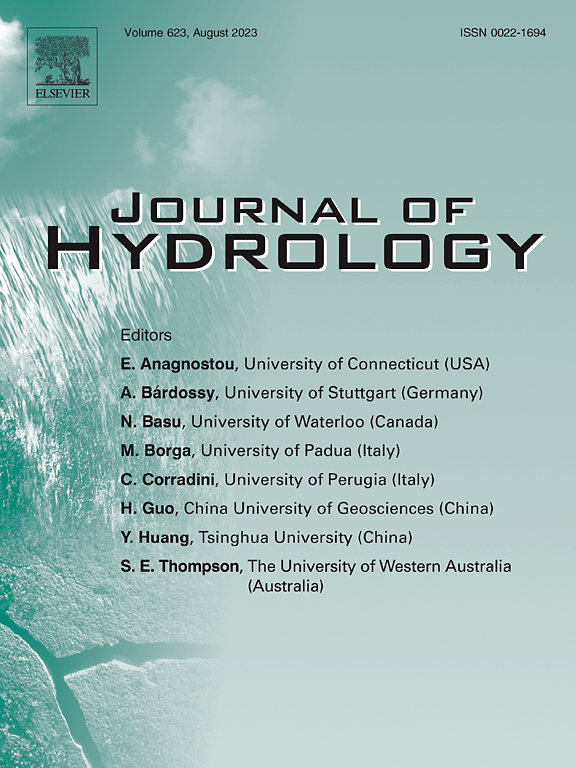A synthesis on the spatial patterns and driving factors of water-holding capacity of forest litter layer across China
IF 5.9
1区 地球科学
Q1 ENGINEERING, CIVIL
引用次数: 0
Abstract
Forest litter layers play a crucial role in regulating hydrological processes and conserving ecosystem water, yet their spatial patterns and key drivers at regional scales remain unclear. By analyzing data from 1062 sampling sites across China using machine learning, we identified the distribution and controlling factors of forest litter mass, litter water-holding rate (LWHR), and litter water-holding amount (LWHA). Our findings reveal that (1) the mean storage of undecomposed and semi-decomposed litter was 6.2 and 10.3 t ha−1, respectively, with a mean LWHR of 247.8 % and LWHA of 34.3 t ha−1; (2) LWHR varied significantly among forest types, being highest in deciduous forests (285.7 %) and lowest in evergreen needleleaf forests (223.5 %); (3) LWHA was greatest in deciduous needleleaf forests (59.7 t ha−1) and lowest in bamboo forests (17.4 t ha−1); (4) both LWHR and LWHA decreased with latitude, indicating regional differences in litter water retention; and (5) climate and topography were the primary drivers of litter water-holding capacity, influencing litter production, accumulation, and decomposition. Our findings provide a scientific basis for forest management strategies aimed at enhancing water conservation, particularly in regions vulnerable to climate change and water shortages. The results also offer a reference for global forest ecosystems, highlighting the importance of litter layers in sustaining water resources and informing policy decisions on forest conservation and watershed management.
中国森林凋落物层持水能力空间格局及驱动因素综合
森林凋落物层在调节水文过程和保护生态系统水分方面发挥着至关重要的作用,但其在区域尺度上的空间格局和关键驱动因素尚不清楚。通过对中国1062个样点的数据进行机器学习分析,确定了凋落物质量、凋落物持水率和凋落物持水量的分布及其控制因素。结果表明:(1)未分解凋落物和半分解凋落物的平均库存量分别为6.2和10.3 tha - 1,平均LWHR为247.8%,LWHA为34.3 tha - 1;(2)不同林型间LWHR差异显著,落叶林最高(285.7%),常绿针叶林最低(223.5%);(3)落叶针叶林的LWHA最高(59.7 t ha−1),竹林最低(17.4 t ha−1);(4)凋落物保水比和枯落物保水比均随纬度降低,表明凋落物保水存在区域差异;⑤气候和地形是凋落物持水能力的主要驱动因素,影响凋落物的产生、积累和分解。我们的研究结果为旨在加强水资源保护的森林管理战略提供了科学依据,特别是在易受气候变化和水资源短缺影响的地区。研究结果还为全球森林生态系统提供了参考,强调了凋落物层在维持水资源和为森林保护和流域管理决策提供信息方面的重要性。
本文章由计算机程序翻译,如有差异,请以英文原文为准。
求助全文
约1分钟内获得全文
求助全文
来源期刊

Journal of Hydrology
地学-地球科学综合
CiteScore
11.00
自引率
12.50%
发文量
1309
审稿时长
7.5 months
期刊介绍:
The Journal of Hydrology publishes original research papers and comprehensive reviews in all the subfields of the hydrological sciences including water based management and policy issues that impact on economics and society. These comprise, but are not limited to the physical, chemical, biogeochemical, stochastic and systems aspects of surface and groundwater hydrology, hydrometeorology and hydrogeology. Relevant topics incorporating the insights and methodologies of disciplines such as climatology, water resource systems, hydraulics, agrohydrology, geomorphology, soil science, instrumentation and remote sensing, civil and environmental engineering are included. Social science perspectives on hydrological problems such as resource and ecological economics, environmental sociology, psychology and behavioural science, management and policy analysis are also invited. Multi-and interdisciplinary analyses of hydrological problems are within scope. The science published in the Journal of Hydrology is relevant to catchment scales rather than exclusively to a local scale or site.
 求助内容:
求助内容: 应助结果提醒方式:
应助结果提醒方式:


